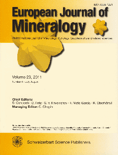
EUROPEAN JOURNAL OF MINERALOGY
Scope & Guideline
Connecting researchers to the core of mineralogical research.
Introduction
Aims and Scopes
- Mineral Characterization and Classification:
The journal emphasizes detailed characterization and classification of minerals, including the discovery of new mineral species and the revision of existing classifications based on chemical, structural, and morphological analyses. - Geochemical Processes and Mineral Formation:
Research on geochemical processes influencing mineral formation, alteration, and stability under various environmental conditions is a core focus, providing insights into the natural processes that govern mineralogy. - Physical and Chemical Properties of Minerals:
Studies exploring the physical and chemical properties of minerals, such as thermal behavior, elasticity, and reactivity, are significant, contributing to a deeper understanding of material behavior in geological contexts. - Technological Applications of Minerals:
The journal also covers the technological applications of minerals, including their use in industrial processes, environmental remediation, and as raw materials in various sectors. - Mineral-Fluid Interactions:
Investigations of mineral-fluid interactions, particularly in hydrothermal systems and during metamorphism, are highlighted, shedding light on the role of fluids in mineral alteration and transport.
Trending and Emerging
- New Mineral Discoveries:
There is a significant trend towards the discovery and characterization of new minerals, reflecting ongoing exploration and advancements in mineral classification. - Nanomaterials and Nanoparticle Studies:
Research focusing on the synthesis, characterization, and application of mineral-based nanoparticles is on the rise, highlighting the relevance of minerals in nanotechnology and materials science. - Mineralogy in Environmental Contexts:
An increasing number of studies are addressing the environmental implications of mineralogy, including the role of minerals in pollution control, resource management, and climate change mitigation. - Advanced Analytical Techniques:
The use of advanced analytical techniques, such as synchrotron radiation, nanoSIMS, and high-resolution imaging methods, is trending, enabling more precise and detailed mineralogical studies. - Interdisciplinary Approaches:
There is a growing trend towards interdisciplinary research that combines mineralogy with geochemistry, materials science, and environmental science, reflecting a holistic approach to mineral studies.
Declining or Waning
- Traditional Petrology Studies:
Research focusing solely on traditional petrology, without incorporating modern analytical techniques or interdisciplinary approaches, appears to be waning, as newer methodologies gain favor. - General Mineralogy without Specific Applications:
Publications that deal with general mineralogy without specific implications for environmental or technological applications have decreased, indicating a trend towards more applied research. - Descriptive Mineralogy:
Papers that focus predominantly on descriptive accounts of minerals, without substantial analytical or experimental data, seem to be less frequent, suggesting a shift towards data-driven studies. - Static Structural Studies:
There is a noticeable decline in research centered exclusively on static structural studies of minerals, with a growing preference for dynamic and experimental approaches.
Similar Journals
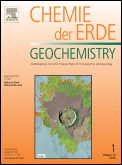
Geochemistry
Advancing Knowledge in Geochemical ProcessesGeochemistry is a distinguished academic journal published by Elsevier GmbH, focusing on the intricate study of geochemical processes across earth systems. With its ISSN 0009-2819 and E-ISSN 1611-5864, this journal serves as a crucial platform for scholars and researchers eager to disseminate their latest findings in geochemistry, petrology, and geophysics. The journal has established itself within the scientific community, achieving a Q2 ranking in both Geochemistry and Petrology as well as Geophysics, showcasing its significant impact and relevance—ranking 18th out of 165 in Geophysics and 26th out of 154 in Geochemistry and Petrology according to Scopus. From its inception in 1978 to its ongoing contributions through 2024, Geochemistry remains a vital resource for academic discourse and innovation in earth sciences. As an open-access title, it allows for broader dissemination of knowledge, promoting accessibility for researchers, students, and professionals. Whether you are engaged in theoretical research or applied studies, Geochemistry provides the insights necessary to advance our understanding of the planet's chemical complexity.
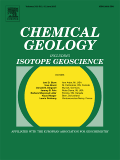
CHEMICAL GEOLOGY
Illuminating Earth’s Mysteries with Cutting-Edge ResearchChemical Geology is an esteemed international journal published by Elsevier, dedicated to the rigorous exploration of geochemistry and petrology, with its foundational roots tracing back to 1966. As evidenced by its impressive Q1 ranking in both Geochemistry and Petrology as well as Geology in the 2023 category quartiles, this journal stands as a premier outlet for cutting-edge research and innovative methodologies within these vital fields. With a Scopus rank placing it in the top 10% of Earth and Planetary Sciences, Chemical Geology offers a platform for researchers, professionals, and students alike to disseminate findings that advance our understanding of geological processes and materials. Although it does not currently offer open-access options, the journal remains committed to high-quality publications that contribute significantly to the scholarly community. Located in the vibrant academic milieu of Amsterdam, Netherlands, Chemical Geology is an essential resource for those engaged in the earth sciences, aiming to bridge theoretical insights with practical applications.
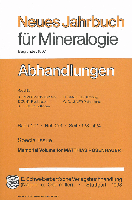
NEUES JAHRBUCH FUR MINERALOGIE-ABHANDLUNGEN
Fostering innovation in geochemistry research.NEUES JAHRBUCH FUR MINERALOGIE-ABHANDLUNGEN, published by E Schweizerbart'sche Verlagsbuchhandlung in Germany, is a distinguished scholarly journal dedicated to advancing the fields of mineralogy and petrology. With an ISSN of 0077-7757, it provides a platform for researchers to disseminate high-quality findings that contribute to our understanding of Earth sciences. Although it currently has no open access options, the journal remains vital for professionals seeking to engage with impactful research in geochemistry and petrology, as reflected in its 2023 Scopus ranking in the 21st percentile within its category. The journal has documented significant research from 1980 to 1988 and resumed from 1996 to 2023, making it a crucial archive for historical and contemporary studies. Despite its current Q4 quartile ranking, NEUES JAHRBUCH FUR MINERALOGIE-ABHANDLUNGEN is an important contributor to the academic discourse in its field, and it invites researchers, professionals, and students alike to explore and submit their work that drives innovation and understanding in mineralogical studies.
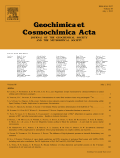
GEOCHIMICA ET COSMOCHIMICA ACTA
Pioneering Research at the Intersection of Earth and CosmosGEOCHIMICA ET COSMOCHIMICA ACTA is a premier journal dedicated to advancing the fields of geochemistry and petrology, published by Pergamon-Elsevier Science Ltd. With its ISSN 0016-7037 and E-ISSN 1872-9533, this esteemed journal has been at the forefront of scientific inquiry since its inception in 1950, with a strong commitment to disseminating high-quality research through 2024. Its reputation is underscored by an impressive impact factor and a ranking of #8 out of 154 in Earth and Planetary Sciences according to Scopus, placing it in the 95th percentile of its category. GEOCHIMICA ET COSMOCHIMICA ACTA serves as a critical resource for researchers, professionals, and students alike, offering insights into the complex interactions of geological and cosmological processes. While the journal is not open access, it remains a vital conduit for innovative research, fostering the scientific community’s understanding of earth materials and their significance.

Mineralogical Journal-Ukraine
Illuminating the path to understanding geochemical processes.Mineralogical Journal-Ukraine is a key academic publication dedicated to advancing the field of mineralogy and geochemistry, under the esteemed auspices of the M.P. Semenenko Institute of Geochemistry, Mineralogy & Ore Formation of NAS Ukraine. Since its inception in 2019, this journal has established itself as an essential resource for researchers and professionals engaged in the study of energy, fuel technology, and the earth sciences, despite its present rankings reflecting a developing impact within these specific categories on Scopus. Published in Ukrainian and available in both print and online formats, the journal not only aims to disseminate high-quality research but also encourages inclusive access to vital findings in mineral exploration, petrology, and geochemical processes. With a commitment to excellence and an expanding scope of research, Mineralogical Journal-Ukraine stands as a pivotal platform for innovation and collaboration among scientists striving to understand the complexities of mineral formation and ore deposits.

AMERICAN MINERALOGIST
Delivering Excellence in Mineralogical ResearchAMERICAN MINERALOGIST, published by the Mineralogical Society of America, stands as a premier journal in the fields of geochemistry and petrology, as well as geophysics, characterized by its prestigious Q1 ranking in both disciplines in 2023. As a vital resource for researchers, professionals, and students, the journal presents cutting-edge research, comprehensive reviews, and innovative methodologies in mineralogy and allied earth sciences. With converged publication years extending from 1968 to the present, it highlights significant advancements and breakthroughs within the realm of mineralogy. The journal's rigorous peer-review process ensures high-quality content that is both informative and impactful, making it essential reading for anyone engaged in earth sciences. Though it does not offer open access, the journal remains widely accessible through academic libraries, providing users with a wealth of knowledge to advance their understanding of mineralogical sciences.
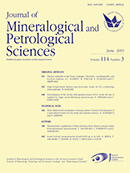
Journal of Mineralogical and Petrological Sciences
Exploring the Depths of Earth’s TreasuresThe Journal of Mineralogical and Petrological Sciences, published by the Japan Association of Mineralogical Sciences, serves as a vital platform for disseminating high-quality research in the fields of mineralogy and petrology. With a presence in both traditional and digital formats (ISSN: 1345-6296; E-ISSN: 1349-3825), this journal fosters scholarly engagement and innovation within these crucial branches of Earth Sciences. As evidenced by its Q3 ranking in both Geology and Geophysics categories for 2023, Journal of Mineralogical and Petrological Sciences maintains a significant standing within the academic community, contributing to the ongoing discourse and exploration of mineralogical phenomena and processes. Researchers, professionals, and students alike will find valuable insights and advancements represented within its pages, with a commitment to inclusivity in research output spanning two decades (2000-2024). Although not currently open access, the journal remains a key resource for understanding the complexities of our geological world.

Canadian Journal of Mineralogy and Petrology
Innovating Discovery: Pioneering Research in Mineralogy and GeochemistryThe Canadian Journal of Mineralogy and Petrology, published by the Mineralogical Association of Canada, is a pioneering platform dedicated to the dissemination of high-quality research in the realms of mineralogy, petrology, and geochemistry. With an increasing focus on global geological challenges, the journal serves as a crucial resource for researchers, professionals, and students alike, offering peer-reviewed articles that reflect the latest advancements in these fields. Although specific metrics such as the impact factor and H-Index are not currently available, the journal is committed to fostering valuable discourse and innovation, thereby enhancing our understanding of Earth's materials. The journal operates under an Open Access model, ensuring that its findings are widely accessible, thus promoting collaborative research and education. Situated in Quebec, Canada, the journal plays a vital role in connecting the international research community with local expertise and discoveries, making it an essential read for anyone involved in mineralogical sciences.

GEOLOGY OF ORE DEPOSITS
Advancing Knowledge in Ore Deposit ScienceGEOLOGY OF ORE DEPOSITS, published by PLEIADES PUBLISHING INC, stands as a pivotal resource in the fields of Economic Geology, Geochemistry, and Petrology. With an ISSN of 1075-7015 and an E-ISSN of 1555-6476, this esteemed journal caters to researchers and professionals by publishing rigorous studies on the formation, distribution, and exploration of mineral deposits. Although it operates under a subscription model, the journal offers insights that are vital for advancing knowledge in geological sciences. As represented in the Scopus rankings, it holds respectable positions within its categories—ranked Q3 in Economic Geology, Geochemistry and Petrology, and Geology for 2023, reflecting its significant contribution to the academic discourse. Covering a comprehensive timeframe from 1996 to 2024, it appeals not only to seasoned scholars but also to students seeking to deepen their understanding of ore deposit geology, thus fostering a rich learning environment and enhancing the field's scientific foundation.
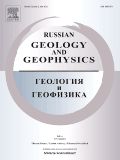
Russian Geology and Geophysics
Exploring the Depths of Geology and GeophysicsRussian Geology and Geophysics is a seminal journal published by GEOSCIENCEWORLD that plays a pivotal role in the dissemination of vital research within the realms of Earth-Surface Processes, Geology, and Geophysics. With an ISSN of 1068-7971 and an E-ISSN of 1878-030X, this journal has witnessed a continuous evolution since its convergence in 2007 and is poised to thrive through 2024. While it is not an Open Access journal, it is recognized for its significant contributions to the academic community, holding a respectable Q2 ranking in Earth-Surface Processes and Q3 rankings in both Geology and Geophysics as of 2023. The journal’s impact factors align it within competitive quartiles, marking it as an essential resource for researchers and professionals seeking to stay at the forefront of geological and geophysical sciences. By publishing high-quality peer-reviewed articles, the journal fosters an environment of knowledge sharing and innovation, making it indispensable for students, practitioners, and scholars alike who are dedicated to advancing our understanding of Earth's complex systems.